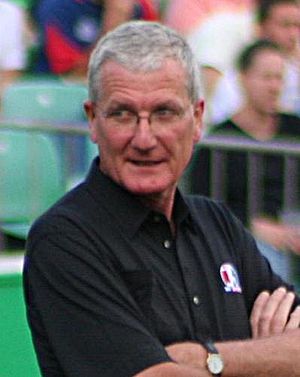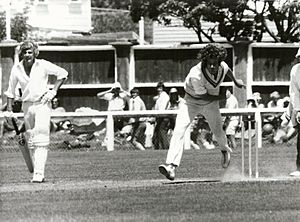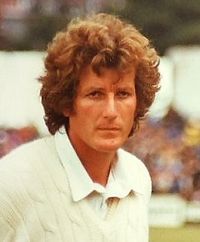Bob Willis facts for kids

Willis on the commentary team at Taunton, 2007
|
||||||||||||||||||||||||||||||||||||||||||||||||||||||||||||||||||
| Personal information | ||||||||||||||||||||||||||||||||||||||||||||||||||||||||||||||||||
|---|---|---|---|---|---|---|---|---|---|---|---|---|---|---|---|---|---|---|---|---|---|---|---|---|---|---|---|---|---|---|---|---|---|---|---|---|---|---|---|---|---|---|---|---|---|---|---|---|---|---|---|---|---|---|---|---|---|---|---|---|---|---|---|---|---|---|
| Full name |
Robert George Dylan Willis
|
|||||||||||||||||||||||||||||||||||||||||||||||||||||||||||||||||
| Born | 30 May 1949 Sunderland, County Durham, England |
|||||||||||||||||||||||||||||||||||||||||||||||||||||||||||||||||
| Died | 4 December 2019 (aged 70) Wimbledon, London, England |
|||||||||||||||||||||||||||||||||||||||||||||||||||||||||||||||||
| Nickname | Goose, Dylan, Harold, Swordfish | |||||||||||||||||||||||||||||||||||||||||||||||||||||||||||||||||
| Height | 6 ft 6 in (1.98 m) | |||||||||||||||||||||||||||||||||||||||||||||||||||||||||||||||||
| Batting | Right-handed | |||||||||||||||||||||||||||||||||||||||||||||||||||||||||||||||||
| Bowling | Right-arm fast | |||||||||||||||||||||||||||||||||||||||||||||||||||||||||||||||||
| Role | Bowler | |||||||||||||||||||||||||||||||||||||||||||||||||||||||||||||||||
| International information | ||||||||||||||||||||||||||||||||||||||||||||||||||||||||||||||||||
| National side |
|
|||||||||||||||||||||||||||||||||||||||||||||||||||||||||||||||||
| Test debut (cap 448) | 9 January 1971 v Australia | |||||||||||||||||||||||||||||||||||||||||||||||||||||||||||||||||
| Last Test | 16 July 1984 v West Indies | |||||||||||||||||||||||||||||||||||||||||||||||||||||||||||||||||
| ODI debut (cap 26) | 5 September 1973 v West Indies | |||||||||||||||||||||||||||||||||||||||||||||||||||||||||||||||||
| Last ODI | 4 June 1984 v West Indies | |||||||||||||||||||||||||||||||||||||||||||||||||||||||||||||||||
| Domestic team information | ||||||||||||||||||||||||||||||||||||||||||||||||||||||||||||||||||
| Years | Team | |||||||||||||||||||||||||||||||||||||||||||||||||||||||||||||||||
| 1969–1971 | Surrey | |||||||||||||||||||||||||||||||||||||||||||||||||||||||||||||||||
| 1970–1977 | Marylebone Cricket Club (MCC) | |||||||||||||||||||||||||||||||||||||||||||||||||||||||||||||||||
| 1972–1984 | Warwickshire | |||||||||||||||||||||||||||||||||||||||||||||||||||||||||||||||||
| 1972/73 | Northern Transvaal | |||||||||||||||||||||||||||||||||||||||||||||||||||||||||||||||||
| Career statistics | ||||||||||||||||||||||||||||||||||||||||||||||||||||||||||||||||||
|
||||||||||||||||||||||||||||||||||||||||||||||||||||||||||||||||||
|
Source: CricketArchive, 7 December 2007
|
||||||||||||||||||||||||||||||||||||||||||||||||||||||||||||||||||
Robert George Dylan Willis (born Robert George Willis; 30 May 1949 – 4 December 2019) was an English cricket player. He played for the England team from 1971 to 1984. Many people think Willis was one of the best fast bowlers ever. He was known for his speed and determination.
Willis is England's fourth-highest wicket-taker in Test cricket history. He took 899 first-class wickets in his career. Even with pain in his knees after surgery, he kept playing well. A famous moment was when he took eight wickets for only 43 runs against Australia in the 1981 Ashes series. This is one of the best bowling performances in Test history. He was named a Wisden Cricketer of the Year in 1978.
Besides Test matches, Willis played 64 One Day International (ODI) games for England, taking 80 wickets. He also took 421 wickets in one-day matches. As a batsman, he usually batted at the end of the lineup. He didn't score many runs, but he did hit two half-centuries in first-class games. Willis was the captain of the England team for 18 Test matches and 28 ODI games between 1982 and 1984. Under his leadership, England won seven Tests and 16 ODIs. His teammate Ian Botham called him "a tremendous trier" and "an inspiration."
Willis retired from cricket in 1984. After that, he became a cricket commentator for Sky Sports. He was known for his calm style. He also wrote books and sometimes shared his opinions on modern cricket. In 2018, he was named in England's greatest Test team. The Bob Willis Trophy was created in 2020 in his honor. In 2021, he was added to the ICC Cricket Hall of Fame.
Contents
Early Life and Cricket Beginnings
Growing Up and Finding Cricket
Robert George Dylan Willis was born in Sunderland on 30 May 1949. When he was six, his family moved to Stoke d'Abernon in Surrey. His father worked for the BBC. Bob had an older brother, David, and an older sister. They often played cricket together in their garden.
In 1965, Bob officially added "Dylan" to his name. He did this to honor the American musician Bob Dylan, who he admired. Bob went to the Royal Grammar School, Guildford. He played cricket for Stoke d'Abernon Cricket Club, where he later became a special member. He also played for Cobham Avorians for two seasons. Bob loved playing football as a schoolboy, even playing as a goalkeeper for a local club.
Developing His Bowling Skills
Bob's talent for bowling was noticed early. He was chosen to play for Surrey Schools and Surrey Colts. These teams helped him develop his skills further. A close friend and mentor, Watcyn Evans, guided him during this time.
Playing Career Highlights
Starting in County Cricket
In 1968, Bob joined a cricket tour to Pakistan with young cricketers from Middlesex and Surrey. This trip helped him improve his game. When he returned, he started playing for Surrey's junior team. His first big match was on 6 August 1969, against Scotland. He took five wickets in that match, helping Surrey win easily.
In his first season, Bob took 22 wickets in six matches. This was a great start for a young player. In 1970, he continued to play well for Surrey, taking 40 wickets. He also had a fantastic performance in a one-day game against Middlesex, taking six wickets for 49 runs. Even though he was doing well, Surrey sometimes chose other bowlers over him.
Joining the England Team
In late 1970, Bob got a surprise call. The captain and vice-captain of the England Test team asked him to join their tour in Australia. Bob went as a replacement for an injured player. He helped England win the Ashes series against Australia.
Bob played his first Test match on 9 January 1971. He took his first Test wicket in that game. He continued to play well, taking 12 wickets in his first Test series. He also caught several important catches. After this, he played two more matches against New Zealand, taking two wickets.
Moving to Warwickshire
In 1971, Bob helped Surrey win the County Championship. But he decided to leave the club and join Warwickshire. He quickly found success there, taking 25 wickets in his first season. Warwickshire also won the Championship in 1972, meaning Bob won the title two years in a row with different teams! In one match, he took eight wickets for only 44 runs against Derbyshire.
Facing Tough Opponents
In 1973, Bob faced the West Indies cricket team. He took four wickets in one match, which was his best Test performance at that time. He also made his ODI debut against them. Later, he toured the Caribbean with England. He found it challenging to bowl against the strong West Indies team throughout his career.
In 1974, Bob played against India and Pakistan. He took four wickets against India and scored his highest Test score of 24 runs at the time. He also toured Australia for the 1974/75 Ashes series, taking 17 wickets. However, he was starting to have knee problems and needed painkilling injections.
Battling Injuries
In 1975, Bob had several operations on both his knees. He even developed a blood clot after surgery. He had to use crutches for a long time and couldn't play international cricket that year. His recovery was tough, involving lots of running and gym work.
He returned to county cricket in 1976 and then played two Tests against the West Indies. He took three wickets in one innings and then five wickets in another, reaching 50 Test wickets. Despite his efforts, England struggled against the West Indies.
A Strong Comeback
The winter of 1976/77 was a turning point for Bob. England toured India, and Bob showed everyone he was one of the world's best fast bowlers. He took 32 wickets on the tour, including 20 in the Test matches. In one match, he took five wickets for 27 runs, and in another, six wickets for 53 runs. This also meant he had taken over 400 first-class wickets.
In the 1977 Ashes series against Australia, Bob played in all five Tests. He took seven wickets in the first Test, showing his "hostile speed." He continued to take wickets throughout the series, finishing with 27 wickets. This was a record for an England fast bowler against Australia at home. His last wicket in the series was his 100th Test wicket. He also took eight wickets for 32 runs in a county match against Gloucestershire, his best first-class figures ever.
Later that year, he toured Pakistan and New Zealand. He took seven wickets against Pakistan and 14 against New Zealand. In one match against New Zealand, he was involved in a famous moment where his teammate Ian Botham ran out their captain, Geoffrey Boycott, to help the team win.
Wisden Cricketer of the Year 1978
In 1978, Bob had a fantastic season. He took 37 wickets in county matches and 16 wickets in the Benson and Hedges Cup. He also took 13 wickets against Pakistan, including a five-wicket haul. He even captained England for the first time in an ODI match.
Wisden, a famous cricket almanac, praised Bob for his amazing bowling in the 1977 Ashes. They said he showed great determination and loyalty to England. He took 65 wickets in all first-class matches that year, his highest ever in a single season. Wisden named him a Cricketer of the Year, recognizing his outstanding achievements.
The 1978–79 Ashes Series
In the winter of 1978/79, Bob toured Australia for another Ashes series. England won the series 5–1. Bob took 20 wickets in the Test series. In the first Test, he took seven wickets, helping England win. He also took five wickets in the second match, as England took a 2–0 lead.
Bob played well throughout the series, helping England secure a convincing victory. He took 34 wickets in all first-class matches on the tour. He also showed some batting skills, scoring 24 runs in one Test match, which was his highest Test score at the time.
1979 Cricket World Cup
In 1979, England hosted the Cricket World Cup. Bob was part of the 13-man squad. England played well, winning their group matches against Australia, Canada, and Pakistan. In the match against Canada, Bob took four wickets for only 11 runs.
England reached the semi-finals, where they beat New Zealand. However, Bob got injured during that match and couldn't play in the final. England lost the final to the West Indies. Despite missing the final, Bob took seven wickets in the tournament and had an excellent economy rate.
After recovering, Bob played in three Test matches against India, taking 10 wickets.
Challenges in 1980
The winter of 1979/80 and the following summer were tough for Bob. He struggled in the Benson and Hedges World Series Cup and a Test tour in Australia. However, he was appointed captain of his county team, Warwickshire.
When the West Indies toured England, Bob showed improved form. He took four wickets in the first innings and five in the second of one Test match. He also scored 24 runs in another Test, helping to save the match. As captain, he led Warwickshire to victory in the John Player League.
The Famous 1981 Ashes Series
The 1981 Ashes series against Australia was one of the most memorable in cricket history. Bob played in all six Test matches. In the first Test, he took three wickets, but England lost. He was then dropped from the team for the second Test due to injury and a chest infection.
However, Bob worked hard to regain his fitness and was brought back for the third Test. This match became legendary. Australia needed 130 runs to win, and England was not expected to win. But Bob started an "inspired" bowling performance. He took eight wickets for only 43 runs, his career-best Test figures. England won by 18 runs, a truly amazing comeback!
Bob continued his great form in the fourth Test, taking two wickets as England won again. In the fifth Test, he contributed with both bat and ball, helping England win by 103 runs. The series ended with England winning 3–1. This series is often called 'Botham's Ashes' because of Ian Botham's incredible performances, but Bob's bowling was crucial.
After the Ashes, Bob toured India and Sri Lanka, taking more wickets for England.
England Captaincy
Leading the Team
In 1982, Bob started the county season well, scoring his highest first-class score of 72 runs. He also reached 750 first-class wickets. Before the Test series against India, Bob was surprisingly chosen to be the captain of the England team.
He led England to two ODI victories against India. Then, in his first Test as captain, he scored a career-best 28 runs and took nine wickets in the match. Wisden described his bowling as "near his fastest." He also took his 250th Test wicket during this match. England won the series against India. Bob also led England to a 2–1 victory in a Test series against Pakistan.
Challenges as Captain
Over the winter of 1982/83, Bob led England in the 1982-83 Ashes series in Australia. He took 28 wickets on the tour. England won one Test match by a very close margin of three runs, with Bob taking three wickets. He said, "You never give up and you never think it has gone." Australia won the series 2–1.
In 1983, Bob captained England in the 1983 Cricket World Cup. England reached the semi-finals but lost to India. He also led England to a 3–1 victory in a Test series against New Zealand, taking 20 wickets. In one match, he passed Fred Trueman's record of 307 Test wickets for England.
Retirement from Cricket
In early 1984, Bob played in a Test series against Pakistan, but injuries limited his performance. Due to his ongoing injuries and the team's struggles, he was replaced as captain by David Gower.
Bob played in the next Test series against the West Indies. In his final Test match on 12 July, he struggled with his bowling. He announced his retirement from all cricket immediately after England's defeat. He played one last major match, leading Warwickshire in the 1984 Benson & Hedges Cup final, which they lost.
Bob finished his career with 325 Test wickets, which was the second-highest at the time. He also took 899 wickets in all first-class matches. Only James Anderson, Ian Botham, and Stuart Broad have taken more Test wickets for England since then. Bob holds the world record for the most Test wickets without ever taking 10 wickets in a single match.
Personal Life
Bob Willis married Juliet Smail in 1980, and they had a daughter in 1984. He later married Lauren Clark in 2014. Although born in Sunderland, Bob grew up in Manchester and was a big fan of Manchester City F.C..
Bob Willis passed away on 4 December 2019, at the age of 70, after a long illness. He had been diagnosed with prostate cancer three years earlier. The Bob Willis Fund was created to raise awareness about prostate cancer and collect money for research. Bob Dylan is an honorary supporter of the fund.
See also
- List of international cricket five-wicket hauls by Bob Willis




